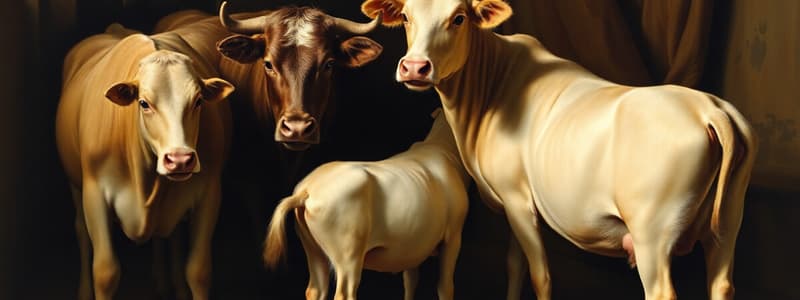Podcast
Questions and Answers
What does animal husbandry primarily focus on?
What does animal husbandry primarily focus on?
- Breeding and raising livestock (correct)
- The decorative purpose of livestock
- Wildlife conservation
- Establishing zoos
Which of the following is NOT considered a type of livestock?
Which of the following is NOT considered a type of livestock?
- Fish (correct)
- Cattle
- Pigs
- Sheep
What is a key focus of feeding practices in animal husbandry?
What is a key focus of feeding practices in animal husbandry?
- Feeding animals only during winter months
- Establishing a diet based on species needs (correct)
- Using only organic feed regardless of species
- Providing unlimited food to all animals
Which of the following practices is significant for ensuring animal welfare?
Which of the following practices is significant for ensuring animal welfare?
What is one of the economic aspects of animal husbandry?
What is one of the economic aspects of animal husbandry?
Which technology is used to enhance livestock breeding decisions?
Which technology is used to enhance livestock breeding decisions?
What is an essential environmental consideration in animal husbandry?
What is an essential environmental consideration in animal husbandry?
Which challenge is related to animal husbandry in the context of health?
Which challenge is related to animal husbandry in the context of health?
What future trend is expected to impact animal husbandry practices?
What future trend is expected to impact animal husbandry practices?
What is an important aspect to consider when implementing waste management in animal husbandry?
What is an important aspect to consider when implementing waste management in animal husbandry?
Flashcards are hidden until you start studying
Study Notes
Definition
- Animal husbandry refers to the science and art of breeding and raising livestock.
Key Concepts
- Types of Livestock: Includes cattle, sheep, goats, pigs, poultry, and other animals used for food, fiber, and other products.
- Breeding: Selective breeding practices aimed at improving desirable traits (growth rate, disease resistance, milk production).
- Feeding: Nutrition management focusing on balanced diets appropriate for the species, age, and production goals.
- Housing: Design and management of facilities to ensure animal welfare, comfort, and protection from weather and predators.
- Health Management: Preventative care, vaccination, and treatment of diseases to maintain animal health and productivity.
Practices
- Pasture Management: Utilizing grazing lands effectively to enhance animal nutrition and soil health.
- Animal Welfare: Ensuring humane treatment, adequate space, and proper care to promote animal well-being.
- Record Keeping: Documentation of breeding, health, and production to inform management decisions and improve productivity.
Economic Aspects
- Market Demand: Understanding consumer preferences and market trends for animal products.
- Sustainability: Implementing practices that reduce environmental impact and promote long-term viability of farming systems.
Technologies in Animal Husbandry
- Genetics: Use of genetic testing to improve breeding decisions.
- Biotechnology: Application of techniques like artificial insemination and embryo transfer for better livestock production.
- Precision Farming: Employing technology for monitoring animal health and optimizing nutrition.
Environmental Considerations
- Waste Management: Strategies to manage manure and reduce pollution.
- Resource Use: Efficient use of water, feed, and land to minimize environmental impact.
Challenges
- Disease Outbreaks: Risk management strategies for zoonotic diseases and biosecurity measures.
- Climate Change: Adapting practices to cope with changing weather patterns and their effects on animal health and production.
Future Trends
- Increased Automation: Use of robotics and AI in feeding, health monitoring, and data analysis.
- Consumer Demand for Ethical Practices: Growing shift towards organic and humane-certified products.
Definition
- Animal husbandry combines science and art in breeding and raising livestock.
Key Concepts
- Types of livestock include cattle, sheep, goats, pigs, and poultry, providing food and fiber.
- Selective breeding enhances traits like growth rate, disease resistance, and milk production.
- Proper feeding entails managing balanced diets tailored to species, age, and production goals.
- Housing design prioritizes animal welfare and shields livestock from adverse weather and predators.
- Health management includes preventative care, vaccinations, and disease treatments to boost productivity.
Practices
- Pasture management optimizes grazing for better animal nutrition and healthier soil.
- Animal welfare principles advocate for humane treatment and adequate living space.
- Detailed record-keeping monitors breeding, health, and production data, informed by management decisions.
Economic Aspects
- Market demand analysis is vital for understanding consumer trends in animal products.
- Sustainability practices aim to lower environmental impacts while ensuring farming viability.
Technologies in Animal Husbandry
- Genetic testing informs breeding decisions for enhanced livestock traits.
- Biotechnology techniques, including artificial insemination and embryo transfer, improve production efficiency.
- Precision farming utilizes technology to monitor health and optimize nutrition effectively.
Environmental Considerations
- Waste management strategies focus on manure processing to minimize pollution.
- Efficient resource use, including water, feed, and land, aims to reduce ecological footprint.
Challenges
- Disease outbreaks require risk management and stringent biosecurity measures.
- Climate change adaptation involves modifying practices to address its impacts on animal health and productivity.
Future Trends
- Increased automation with robotics and AI enhances feeding processes, health monitoring, and data analytics.
- Growing consumer demand emphasizes ethical practices, leading to a shift towards organic and humane-certified products.
Studying That Suits You
Use AI to generate personalized quizzes and flashcards to suit your learning preferences.




